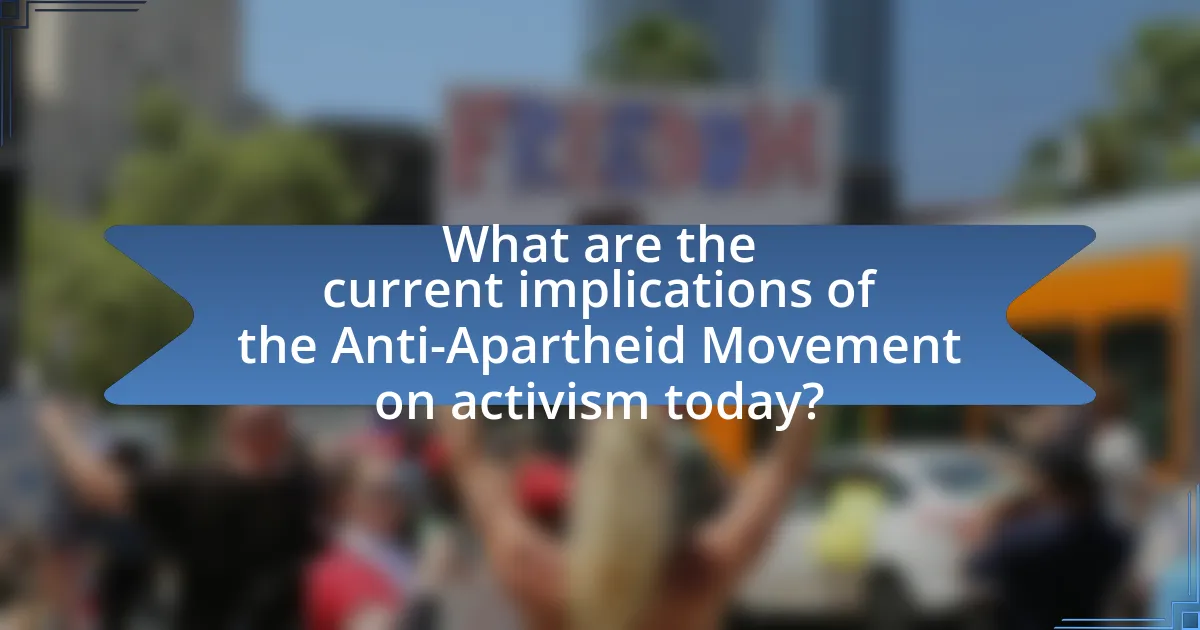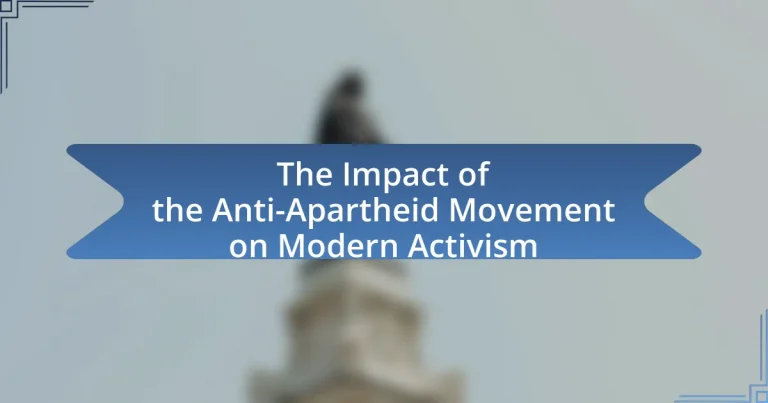The Anti-Apartheid Movement was a global campaign aimed at ending racial segregation and discrimination in South Africa from 1948 to the early 1990s. This movement mobilized international support through protests, boycotts, and sanctions, significantly influencing public opinion and policy. Key events such as the Sharpeville Massacre and the Soweto Uprising galvanized activism, while prominent figures like Nelson Mandela and Desmond Tutu played crucial roles in the struggle. The movement’s legacy continues to impact modern activism, emphasizing grassroots organizing, international solidarity, and the importance of education in advocating for social justice and human rights today.

What was the Anti-Apartheid Movement?
The Anti-Apartheid Movement was a global campaign aimed at ending the system of racial segregation and discrimination enforced by the South African government from 1948 until the early 1990s. This movement mobilized international support through protests, boycotts, and sanctions against South Africa, significantly influencing global public opinion and policy. Key events included the Sharpeville Massacre in 1960, which drew worldwide condemnation, and the establishment of the African National Congress as a leading force in the struggle against apartheid. The movement’s efforts culminated in the release of Nelson Mandela in 1990 and the subsequent dismantling of apartheid laws, marking a pivotal moment in the fight for human rights and social justice.
How did the Anti-Apartheid Movement begin?
The Anti-Apartheid Movement began in the early 20th century as a response to the institutionalized racial segregation and discrimination enforced by the South African government. The movement gained momentum in the 1940s and 1950s, particularly with the formation of the African National Congress (ANC) in 1912, which aimed to fight for the rights of black South Africans. Key events, such as the Defiance Campaign in 1952, marked significant organized resistance against apartheid laws. The movement was characterized by widespread protests, international advocacy, and solidarity actions, which ultimately contributed to the dismantling of apartheid in the early 1990s.
What were the key events that sparked the movement?
The key events that sparked the anti-apartheid movement include the 1948 implementation of apartheid laws in South Africa, the Sharpeville Massacre in 1960, and the Soweto Uprising in 1976. The apartheid laws institutionalized racial segregation and discrimination, igniting widespread resistance. The Sharpeville Massacre, where police killed 69 peaceful protesters, drew international condemnation and heightened global awareness of the injustices in South Africa. The Soweto Uprising, a student-led protest against the imposition of Afrikaans in schools, resulted in significant casualties and galvanized further activism both domestically and internationally. These events collectively mobilized support for the anti-apartheid cause and laid the groundwork for future activism against systemic oppression.
Who were the prominent figures in the Anti-Apartheid Movement?
The prominent figures in the Anti-Apartheid Movement included Nelson Mandela, Desmond Tutu, Oliver Tambo, and Walter Sisulu. Nelson Mandela, as a leader of the African National Congress (ANC), became the face of the struggle against apartheid, enduring 27 years in prison before becoming South Africa’s first Black president in 1994. Desmond Tutu, an Anglican bishop, used his religious platform to advocate for nonviolent resistance and reconciliation. Oliver Tambo, also a key ANC leader, played a crucial role in garnering international support against apartheid. Walter Sisulu, a mentor to Mandela, was instrumental in organizing resistance efforts and mobilizing the ANC. These figures collectively shaped the movement, leading to the eventual dismantling of apartheid in the early 1990s.
What were the main goals of the Anti-Apartheid Movement?
The main goals of the Anti-Apartheid Movement were to dismantle the system of apartheid in South Africa and to promote racial equality and human rights. The movement aimed to end the institutionalized racial segregation and discrimination enforced by the apartheid regime, which began in 1948. Key objectives included advocating for the liberation of political prisoners, promoting economic sanctions against the South African government, and mobilizing international support to pressure for change. The movement’s effectiveness is evidenced by the eventual release of Nelson Mandela in 1990 and the establishment of a multiracial democracy in South Africa in 1994, marking a significant victory against apartheid.
How did the movement aim to achieve racial equality?
The movement aimed to achieve racial equality through organized protests, legal challenges, and international advocacy. By mobilizing mass demonstrations, such as the Sharpeville Massacre protests in 1960, the movement highlighted the brutality of apartheid and garnered global attention. Legal strategies included court cases that challenged discriminatory laws, exemplified by the 1980s legal battles against the pass laws. Additionally, the movement sought international support, leading to economic sanctions and divestment campaigns against South Africa, which pressured the government to dismantle apartheid policies. These combined efforts were instrumental in achieving significant political changes, culminating in the first multiracial elections in 1994.
What strategies were employed by activists during the movement?
Activists during the anti-apartheid movement employed a variety of strategies, including mass protests, international advocacy, and economic boycotts. Mass protests, such as the Sharpeville Massacre in 1960, galvanized global attention and support against apartheid policies. International advocacy involved lobbying foreign governments and organizations to impose sanctions on South Africa, which significantly pressured the apartheid regime. Economic boycotts targeted companies operating in South Africa, aiming to weaken the economy and draw attention to the injustices of apartheid. These strategies collectively contributed to the eventual dismantling of apartheid and have influenced modern activism by demonstrating the power of coordinated grassroots efforts and global solidarity.
What impact did the Anti-Apartheid Movement have on South Africa?
The Anti-Apartheid Movement significantly contributed to the dismantling of institutionalized racial segregation in South Africa. This movement mobilized international support and led to economic sanctions against the apartheid regime, culminating in the release of Nelson Mandela in 1990 and the subsequent transition to a democratic government in 1994. The movement’s advocacy for human rights and equality laid the groundwork for ongoing social justice efforts in South Africa, influencing contemporary activism focused on issues such as land reform and economic inequality.
How did the movement influence the end of apartheid?
The anti-apartheid movement significantly influenced the end of apartheid by mobilizing international pressure and fostering internal resistance against the South African government. This movement, which included global protests, economic sanctions, and cultural boycotts, raised awareness about the injustices of apartheid and garnered widespread support for the liberation struggle. For instance, the imposition of economic sanctions by countries and organizations, such as the United Nations, directly impacted South Africa’s economy, compelling the government to reconsider its policies. Additionally, the internal resistance, exemplified by groups like the African National Congress and figures such as Nelson Mandela, galvanized public sentiment and demonstrated the unyielding demand for equality and justice. The culmination of these efforts led to negotiations that ultimately dismantled apartheid in the early 1990s, marking a pivotal moment in South African history.
What were the social and political changes following the movement?
The social and political changes following the Anti-Apartheid Movement included the dismantling of institutionalized racial segregation in South Africa and the establishment of a democratic government. The end of apartheid in 1994 led to the election of Nelson Mandela as the first Black president, symbolizing a significant shift towards equality and human rights. This transition also inspired global movements advocating for social justice, influencing activism worldwide by emphasizing the importance of grassroots organizing and international solidarity. The movement’s legacy is evident in contemporary campaigns against systemic racism and inequality, demonstrating its lasting impact on modern activism.

How did the Anti-Apartheid Movement influence modern activism?
The Anti-Apartheid Movement significantly influenced modern activism by establishing a framework for global solidarity and grassroots mobilization against systemic injustice. This movement demonstrated the effectiveness of coordinated international pressure, exemplified by economic sanctions and divestment campaigns that ultimately contributed to the end of apartheid in South Africa. The strategies employed, such as mass protests, advocacy for human rights, and the use of media to raise awareness, have been adopted by contemporary movements like Black Lives Matter and climate activism. These modern movements utilize social media to mobilize support and create awareness, reflecting the Anti-Apartheid Movement’s legacy of leveraging communication for social change.
What lessons can modern activists learn from the Anti-Apartheid Movement?
Modern activists can learn the importance of sustained grassroots mobilization from the Anti-Apartheid Movement. This movement effectively utilized mass protests, boycotts, and international solidarity to challenge systemic oppression, demonstrating that collective action can lead to significant political change. For instance, the global boycott of South African goods and the divestment campaigns in universities and institutions played a crucial role in applying economic pressure on the apartheid regime, ultimately contributing to its dismantling in the early 1990s. This historical context illustrates that coordinated efforts and public engagement are vital for modern movements seeking to address social injustices.
How did the movement shape contemporary protest strategies?
The Anti-Apartheid Movement significantly shaped contemporary protest strategies by introducing tactics such as mass mobilization, international solidarity, and the use of nonviolent resistance. These strategies were exemplified through large-scale protests, boycotts, and divestment campaigns that garnered global attention and support, effectively pressuring governments and institutions to take action against apartheid. For instance, the movement’s success in organizing the 1989 international boycott of South African goods demonstrated the power of collective action and consumer influence, which has since been adopted by modern movements like Black Lives Matter and climate activism. This historical context illustrates how the Anti-Apartheid Movement’s innovative approaches to activism have become foundational elements in the toolkit of contemporary protest strategies.
What role did international solidarity play in the movement’s success?
International solidarity was crucial to the success of the anti-apartheid movement, as it mobilized global support and resources against the apartheid regime in South Africa. This support manifested through economic sanctions, cultural boycotts, and political pressure from various countries and organizations, which collectively isolated the apartheid government. For instance, the United Nations General Assembly adopted Resolution 3314 in 1974, calling for the imposition of sanctions against South Africa, which significantly contributed to the regime’s eventual dismantling. Additionally, grassroots movements worldwide, such as the Anti-Apartheid Movement in the UK, raised awareness and funds, amplifying the voices of South African activists and fostering a sense of global responsibility.
In what ways has the Anti-Apartheid Movement inspired global movements?
The Anti-Apartheid Movement has inspired global movements by demonstrating the effectiveness of grassroots activism, international solidarity, and nonviolent resistance. This movement mobilized worldwide support against racial injustice, leading to significant political changes in South Africa and influencing other struggles for civil rights and social justice globally. For instance, the global boycott of South African goods and divestment campaigns in the 1980s showcased how coordinated international efforts could pressure governments and corporations to change policies. Additionally, the movement’s emphasis on human rights has resonated with various contemporary movements, such as Black Lives Matter and climate justice initiatives, which adopt similar strategies of advocacy and awareness-raising to combat systemic oppression and inequality.
What parallels can be drawn between the Anti-Apartheid Movement and current social justice movements?
The Anti-Apartheid Movement and current social justice movements share significant parallels in their goals of combating systemic inequality and advocating for human rights. Both movements utilize grassroots organizing and international solidarity to raise awareness and mobilize support against oppressive systems. For instance, the Anti-Apartheid Movement effectively employed boycotts, divestments, and sanctions to pressure the South African government, a strategy mirrored in contemporary movements like Black Lives Matter, which calls for divestment from police funding and systemic reforms. Additionally, both movements highlight the importance of intersectionality; the Anti-Apartheid Movement recognized the interconnectedness of racial, economic, and social injustices, a principle that current social justice movements also emphasize in addressing issues such as gender inequality and LGBTQ+ rights. These shared strategies and principles illustrate how historical activism informs and shapes modern efforts for social change.
How have modern activists adopted the principles of the Anti-Apartheid Movement?
Modern activists have adopted the principles of the Anti-Apartheid Movement by employing strategies such as grassroots organizing, international solidarity, and nonviolent resistance. These activists draw inspiration from the successful mobilization tactics used by the Anti-Apartheid Movement, which united diverse groups against systemic injustice in South Africa. For instance, contemporary movements like Black Lives Matter utilize social media to amplify their messages and foster global support, mirroring the global awareness campaigns that were pivotal during the Anti-Apartheid struggle. Additionally, modern activists advocate for economic boycotts and divestment, similar to the sanctions imposed on South Africa, to challenge oppressive systems and promote social justice.

What are the current implications of the Anti-Apartheid Movement on activism today?
The current implications of the Anti-Apartheid Movement on activism today include the establishment of global solidarity networks and the emphasis on intersectionality in social justice movements. The Anti-Apartheid Movement demonstrated the power of international advocacy and grassroots mobilization, leading to the formation of coalitions that address various forms of oppression, such as racial injustice, economic inequality, and human rights violations. For instance, contemporary movements like Black Lives Matter and climate justice initiatives draw inspiration from the strategies and successes of the Anti-Apartheid Movement, utilizing social media to mobilize support and raise awareness. This historical context reinforces the importance of collective action and the interconnectedness of struggles for justice, illustrating how past movements continue to shape current activism.
How does the legacy of the Anti-Apartheid Movement manifest in today’s activism?
The legacy of the Anti-Apartheid Movement manifests in today’s activism through the continued emphasis on social justice, human rights, and global solidarity. Activists today draw inspiration from the strategies employed during the Anti-Apartheid Movement, such as grassroots organizing, international advocacy, and the use of boycotts to challenge systemic oppression. For instance, movements like Black Lives Matter and climate justice campaigns echo the principles of collective action and intersectionality that were central to the Anti-Apartheid struggle. Furthermore, the global response to apartheid highlighted the importance of international coalitions, which is evident in contemporary activism that seeks to unite diverse groups against issues like racial inequality and environmental degradation. This ongoing influence underscores the enduring relevance of the Anti-Apartheid Movement in shaping modern approaches to activism.
What are the ongoing challenges that activists face today?
Activists today face ongoing challenges such as governmental repression, misinformation, and social media censorship. Governmental repression includes tactics like surveillance, arrests, and legal restrictions aimed at stifling dissent, as evidenced by reports from organizations like Amnesty International, which highlight increased crackdowns on protests in various countries. Misinformation campaigns, often propagated through social media, undermine public trust and distort the narratives surrounding social justice issues, complicating activists’ efforts to mobilize support. Additionally, social media platforms frequently impose content moderation policies that can inadvertently silence activist voices, as seen in cases where posts related to sensitive political issues are removed or flagged. These challenges hinder the effectiveness and reach of modern activism, echoing historical struggles faced during movements like the Anti-Apartheid Movement.
How can the Anti-Apartheid Movement’s strategies be adapted for current issues?
The strategies of the Anti-Apartheid Movement can be adapted for current issues by employing grassroots mobilization, international solidarity, and targeted economic pressure. Grassroots mobilization, exemplified by the mass protests and community organizing during the Anti-Apartheid Movement, can be utilized today to raise awareness and engage communities on issues such as climate change or racial injustice. International solidarity, demonstrated through global campaigns and partnerships, can be leveraged to unite diverse groups against common challenges, fostering a sense of shared purpose. Targeted economic pressure, similar to the divestment campaigns against companies supporting apartheid, can be applied to corporations contributing to social injustices or environmental degradation, encouraging ethical consumerism and corporate accountability. These adaptations reflect the enduring relevance of the Anti-Apartheid Movement’s strategies in addressing contemporary social and political issues.
What practical steps can activists take to honor the Anti-Apartheid Movement’s legacy?
Activists can honor the Anti-Apartheid Movement’s legacy by promoting social justice initiatives that reflect its principles of equality and human rights. Engaging in educational campaigns about the history and impact of apartheid can raise awareness and inspire action against contemporary injustices. Additionally, supporting organizations that fight for racial equality and economic justice continues the movement’s work. For instance, the Anti-Apartheid Movement successfully mobilized global support, which activists today can replicate by leveraging social media to advocate for marginalized communities. Historical evidence shows that grassroots mobilization was crucial in dismantling apartheid, demonstrating that collective action remains a powerful tool for change.
How can grassroots organizing be effectively utilized in modern activism?
Grassroots organizing can be effectively utilized in modern activism by fostering community engagement and mobilizing collective action. This approach empowers individuals at the local level to address social issues, as seen in the Anti-Apartheid Movement, which relied on grassroots efforts to build international support and pressure governments. Historical evidence shows that grassroots campaigns, such as the divestment movement against South African apartheid, successfully raised awareness and influenced policy changes by uniting diverse groups around a common cause. By leveraging social media and local networks, modern activists can replicate these strategies to amplify their voices and drive systemic change.
What role does education play in sustaining the movement’s impact?
Education plays a crucial role in sustaining the impact of the anti-apartheid movement by fostering awareness, critical thinking, and activism among new generations. Through educational programs and curricula that highlight the history and lessons of the anti-apartheid struggle, individuals are equipped with the knowledge necessary to understand systemic injustices and advocate for social change. For instance, studies have shown that educational initiatives focused on social justice can increase civic engagement and empower individuals to participate in movements addressing contemporary issues, such as racial inequality and human rights violations. This ongoing education ensures that the values and lessons of the anti-apartheid movement continue to resonate, inspiring sustained activism and advocacy for equality.


